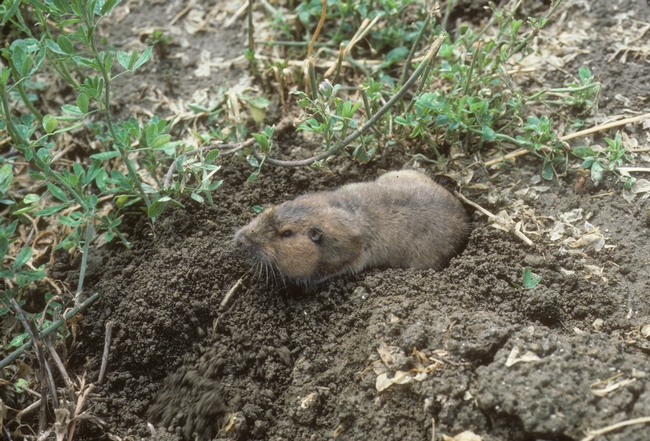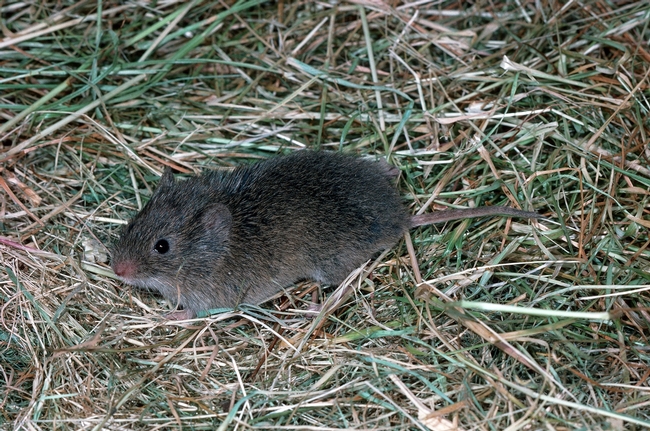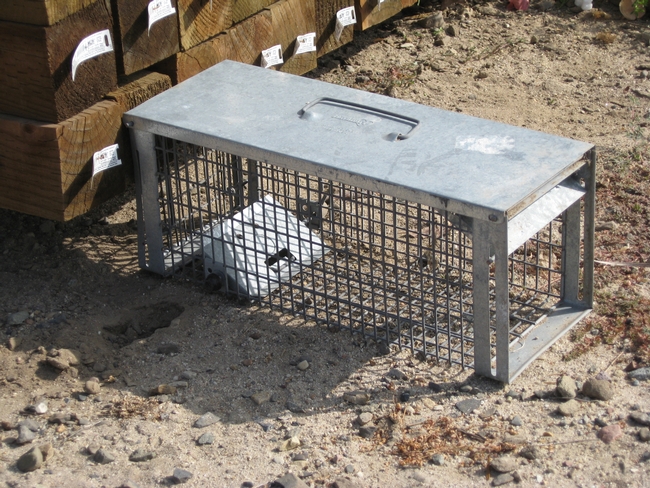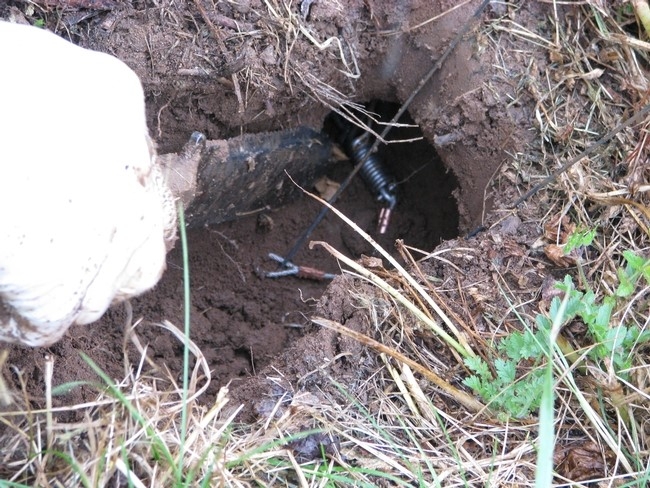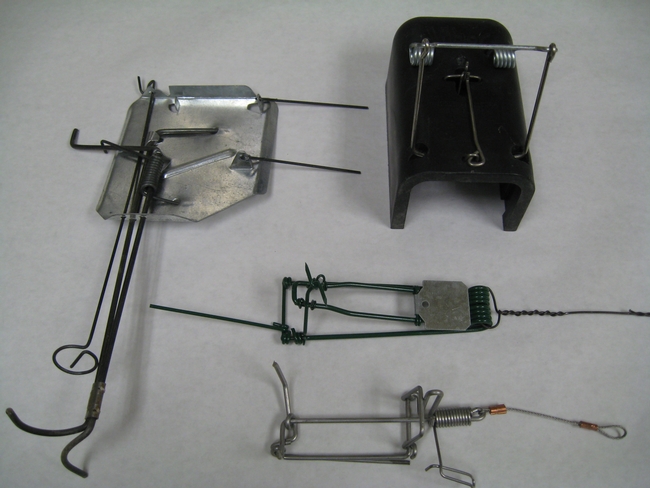
Posts Tagged: rodents
Organic Control of Rodents
Burrowing Rodents: Developing a
Management Plan
for Organic Agriculture in CA
RELATED ITEMS
- California ground squirrels Otospermophilus spp.
- Pocket Gophers Thomomys spp.
- Meadow voles Microtus spp.
This free publication is available by download.
This publication is best viewed using the free Adobe® Acrobat® Reader. You can download a free copy of the Acrobat Reader from Adobe Systems Incorporated.

ground squirrel
Burrowing Varmints Guide
- Author: Pamela Kan-Rice
Burrowing rodents can cause extensive and expensive damage to orchards and crop fields. To manage the pests without chemicals used on conventional farms, organic growers can consult a new publication from UC Agriculture and Natural Resources scientists.
“Burrowing Rodents: Developing a Management Plan for Organic Agriculture in California” outlines management within organically acceptable methods using an integrated pest management approach.
California ground squirrels, pocket gophers and meadow voles are the three most common species that cause damage. Squirrels chew on seedlings, fruit and nuts, killing young trees and reducing crop yields. In addition to plants, ground squirrels, pocket gophers and voles can chew on irrigation lines, and their burrow systems can channel water away from plants and erode the soil. The holes and mounds created by burrowing rodents pose hazards to farmworkers and farm machinery.
Meadow mouse or vole that can girdle a tree if you aren't watching
This publication helps growers identify the rodent species on their properties, their life cycles and tools available to control them.
“Growers can read about how to effectively select and set a range of traps for burrowing rodents,” said co-author Margaret Lloyd, UC Cooperative Extension small farms advisor for the Capitol Corridor. “Traps are an important tool for organic management, but maximizing control comes from integrating knowledge. Here we present information about rodent biology, trap efficacy, biocontrol, habitat management, plant protection and other approaches to collectively manage the pest problem.”
In the publication, Lloyd and Roger Baldwin, UC Cooperative Extension wildlife specialist in the UC Davis Department of Wildlife, Fish and Conservation Biology, review the effectiveness of commercially available traps – where to place the traps, whether to use attractants, and methods of euthanizing the animals.
They also offer cultural techniques for deterring rodents such as flooding fields and deep ripping soil to destroy burrow systems. Crops for orchard floors or cover cropping can be selected and managed to minimize habitat that protects and encourages gophers and voles.
For biological control, they suggest barn owls, raptors and snakes might be able to assist, but warn growers that predators alone will not be able to eat enough of the rodents to reduce the high populations to tolerable levels for many growers.
“Effective management will rely on a suite of tools,” said Baldwin.
The 15-page publication is available for free download at https://anrcatalog.ucanr.edu/Details.aspx?itemNo=8688.
Got Voles?
Baldwin and Meinerz are UC Davis and Witmer and Werner are USDA/APHIA/Wildlife Services-National Wildlife Research Center
Voles are short, stocky rodents that often cause extensive girdling damage to a variety of tree and vine crops throughout California. Vole management is often quite challenging given how numerous they can be in a given area. In more recent years, effective management has often relied on some combination of vegetation removal, exclusion using trunk protectors, and rodenticide application. Vegetation removal is a great tool for reducing numbers in a field, but doesn't always eliminate all problems in an area. Plus, vole population size tends to ebb and flow from low to high densities; when densities are high, vegetation removal is often insufficient to reduce girdling damage.
Exclusion through the use of trunk protectors can be a good way to reduce girdling damage as well. However, trunk protectors should be buried at least 6 inches below ground to keep voles from tunneling underneath the protectors. This substantially increases the amount of labor required to protect trees and vines. Ultimately, this approach is only cost effective if high levels of damage are anticipated.
Rodenticide applications are also frequently used to knock down vole populations. However, rodenticide applications are generally not allowable within an orchard or vineyard during the growing season, thereby eliminating the use of one of the most effective vole management tools when it is most needed. Clearly there is room for a new tool to be added to the proverbial IPM toolbox when it comes to managing voles in orchard and vine crops.
Chemical repellents are one such tool that could be considered. Historically, repellents have not proven overly effective for field application against voles. However, recent laboratory testing of anthraquinone indicated that even low concentrations of this chemical were effective at reducing grain consumption by voles. Furthermore, anthraquinone has proven effective as a bird repellent. Anthraquinone is a post-ingestive product that causes animals that consume the product to become ill, thereby making it less likely that the animal will consume the product again during a subsequent feeding event. This kind of repellent is ideally suited for trunk application given that the repellent can easily be applied to the portion likely to be consumed by the vole. If effective, minimal girdling damage should be observed. A repellent application also has the added advantage in that it can easily be paired with vegetation management to hopefully further reduce girdling damage when compared to using either one of these approaches alone. Therefore, we set up a study to test the potential impact that a combination of vegetation management and anthraquinone applications would have on girdling damage by voles to young citrus trees. We also tested the longevity of anthraquinone to determine if long-term repellency following field application was likely. We tested this impact during both spring (characterized by a cool-wet weather pattern) and summer (characterized by a hot-dry weather pattern) seasons to determine if weather impacted potential girdling damage.
We found that anthraquinone was in fact highly repellent following trunk application, with a >90% reduction in girdling damage observed following application regardless of the season when it was applied. Anthraquinone exhibited substantial longevity, with no increase in girdling damage observed for the entire summer (5 weeks) and spring (6 weeks) sampling periods. This clearly indicates substantial repellency for anthraquinone applications, with repellency to last for at least two months, and likely for much longer given that we observed no upward trend at all in girdling damage at the end of our study period.
When combined with anthraquinone treatments, the removal of vegetation completely eliminated all girdling damage during summer. However, we did not observe this same collective impact during spring. That said, the inclusion of vegetation management with anthraquinone applications is likely warranted given our understanding of the need for multiple management strategies to maintain the long-term effectiveness of rodent management programs.
These results clearly indicate effective repellency of voles following anthraquinone applications, but at this time, anthraquinone is not registered for use against any mammalian species. We are hoping to gauge the interest of growers for the registration of this repellent against voles in orchard and vine crops. This is where we need your help. We have developed a very short survey (will take less than 3 minutes to complete) to gauge this interest. Please take this very quick survey to assist in this effort:
https://ucanr.edu/survey/survey.cfm?surveynumber=24480
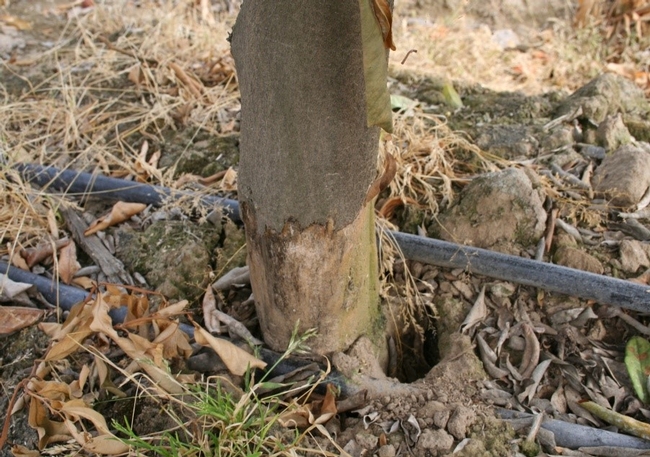
vole 7
Watch Out for Those Rodents - They are After Your Trees
redcThe hills have been dry for a long time, and the long dry fall is bringing animals into the avocado groves that normally stay out in the hills. They want the green cambium of trees and the moisture it provides. And especially rodents will have a field day in the well-maintained orchards.
Gophers are not usually a problem in mature avocados. They will often chew the bark below ground. Ground squirrels when they get hungry can go after just about any part of the tree, trunk branches and fruit. Voles or meadow mice will go after bark about 2 inches above ground. Rabbits can take out bark up to a foot above ground. This bark damage often leads to the yellowing of the canopy and if damage is extensive enough, wilting of the canopy. Growers don't normally see the damage until they see the wilted tree and start looking for the problem. If healing along the margins of the damage is occurring, it means it was damage that was done previously. If margins are still ragged, it means the beasts are still enjoying the tree. Trapping, poisons and a busy Jack Russell terrier are all effective, especially if used together. Voles especially like mulch around the base of the tree, and should be pulled away a foot to 18 inches. They make tunnels thought the mulch which then becomes a diagnostic for identifying the cause.
It's not just avocados that are ravaged by these animals. Citrus is like candy to them and then there's all those acres and acres of almonds that have been planted.
Avocado canopy collapse. Why? Check the tree out. See the red squirrel feeding stations in the background?
Damage that is healing over.

avocado collapsing

avocado rodent damage 2
Rats in Your Orchard
The roof rat (Rattus rattus), sometimes called the black rat, is a common vertebrate pest in citrus, avocado and other yummy tree orchards. It builds leaf and twig nests in fruit trees or nearby trees, or it can nest in debris piles or thick mulch on the ground. This agile, sleek rat has a pointed muzzle, and a tail that is longer than the body and head combined.
Be sure to identify the species of rat present to avoid killing nontarget or protected species. Be aware that endangered native kangaroo rats (Dipodomys spp.) and the riparian woodrat (Neotoma fuscipes riparia) resemble pest rats, but are protected by law. Unlike the hairless, scale-covered tail of roof rats, the tails of kangaroo rats and the riparian woodrat are covered with fur. The riparian woodrat is active mostly during the day, and its tail is somewhat shorter than the combined length of its body and head. A kangaroo rat's tail is noticeably longer than its body and head combined. Kangaroo rats are nocturnal, but unlike Norway rats and roof rats, which move on all four legs, kangaroo rats hold their front legs off the ground and travel by hopping on their hind legs.
Rats gnaw on electrical wires, wooden structures, and fruit on trees. After harvest, they damage fruit in bins, chewing on the bins and leaving excrement. Rats are active throughout the year, and mostly at night.
To help manage rats, reduce shelter and nesting sites of rats. Eliminate debris and wood piles. Store materials neatly and off the ground. Thin and separate non-crop vegetation around orchards where feasible. Exclude rats from nearby structures by properly sealing entry ways.
Baits and rat-sized snap traps placed in trees are the most effective control measures. Rats are wary, tending to avoid baits and traps for at least a few days after their initial placement. Fasten traps to limbs and bait them with sweet fruit or nut meats, but do not set the traps until after bait is readily eaten. Secure anticoagulant wax blocks in a bait station before placing in trees on limbs 6 feet or more above the ground. Placing the wax blocks in a bait station will prevent chunks of the anticoagulant wax from dropping to the ground and creating a hazard.
Be aware that certain types of single-dose rat baits for use inside buildings are not labeled for use outdoors in orchards; these are hazardous to wildlife and should not be used.
For more on the subject see:
http://icwdm.org/handbook/allPDF/RO_B125.PDF
http://www.ipm.ucdavis.edu/PMG/PESTNOTES/pn74106.html
and another blog:
//ucanr.edu/blogs/blogcore/postdetail.cfm?postnum=16880
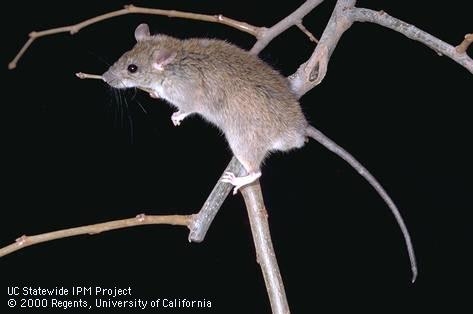
roof rat
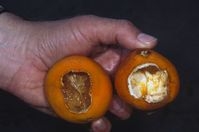
rat damage to citrus

